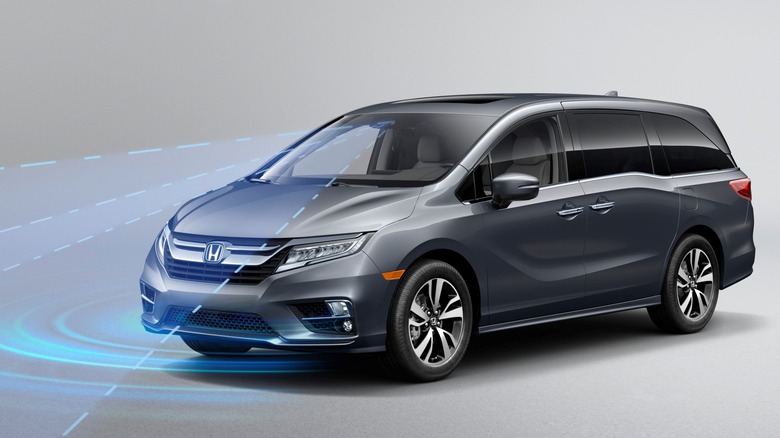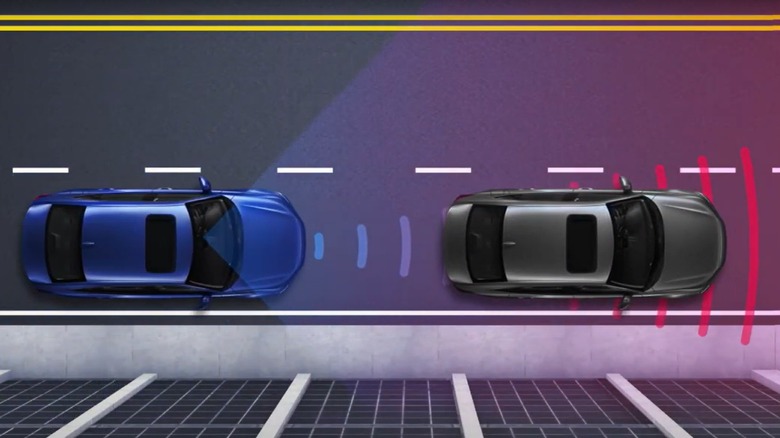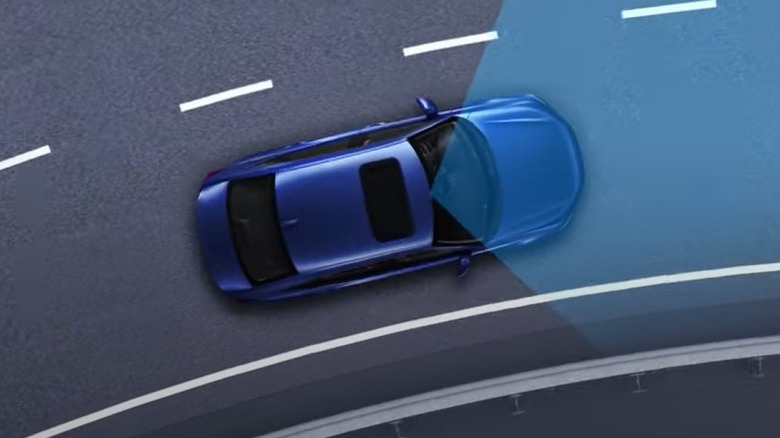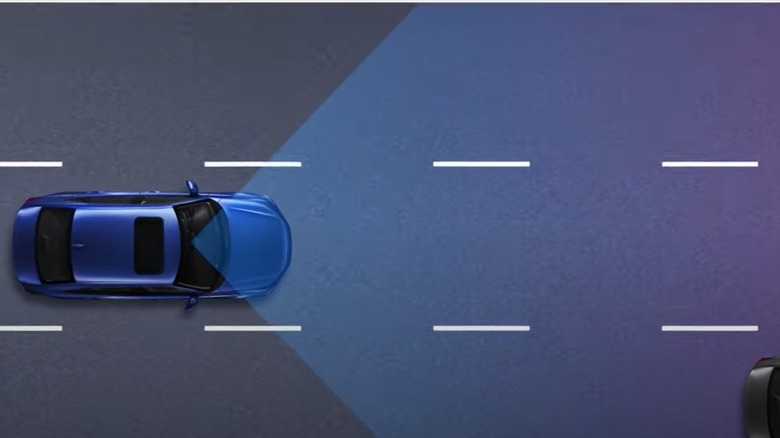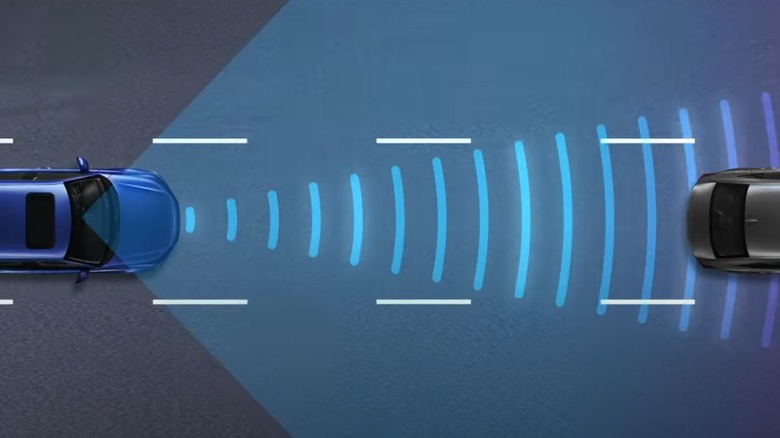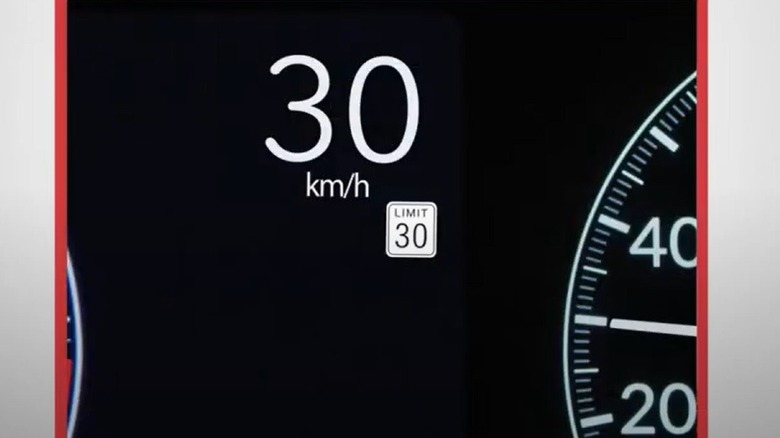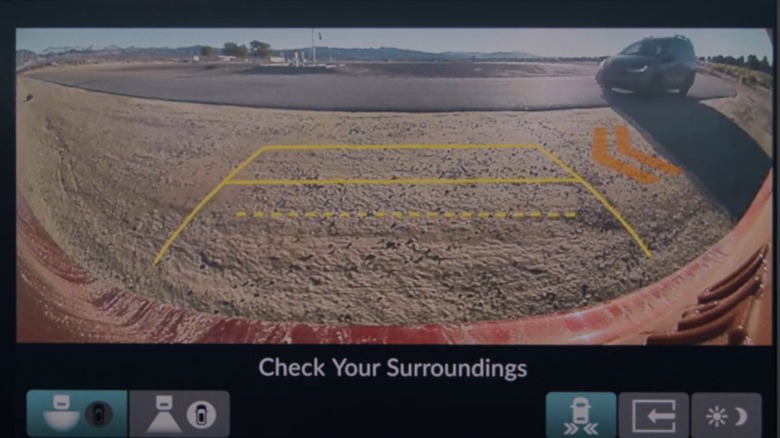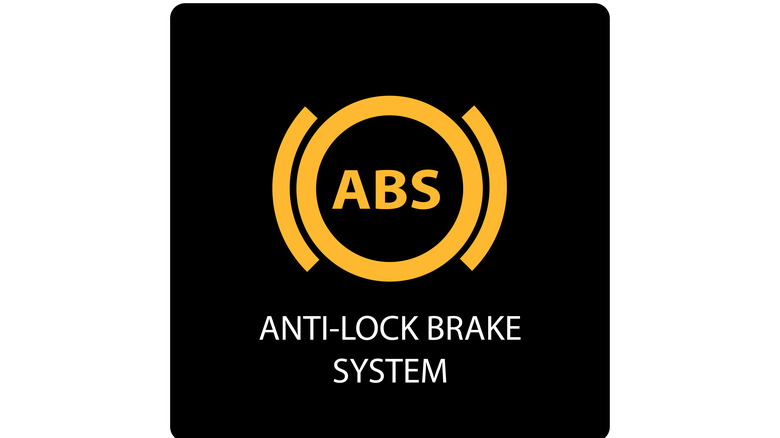14 Honda Safety Features Every Cautious-Minded Driver Will Want To Know About
Drivers know that Honda makes some of the most reliable cars on the road, but it deserves to be recognized for its leadership in safety technology, too. Honda's safety features are part of its commitment to creating what it calls a collision-free future. Their engineers design cars, trucks, minivans, and SUVs that not only protect their occupants during accidents, but also help drivers to avoid crashes altogether.
Since truly autonomous self-driving cars still lie at some point in the future, Honda hopes to accomplish the second-best thing by giving drivers a smart copilot. From computer-designed impact-absorbing frames to advanced driver-assist technology, Honda aims to be a world leader in safety. The carmaker's ratings from the Insurance Institute for Highway Safety (IIHS) reflect their success in achieving this goal, year in and year out.
For instance, in the IIHS 2024 ratings, nearly every Honda model received either a Top Safety Pick or Top Safety Pick+ award. The Civic hatchback, CR-V, and Odyssey were noted as Top Safety Picks, while the Civic sedan, Accord, HR-V, and Pilot all got the nod as Top Safety Pick+ winners. Both ratings are very similar, with the plus sign indicating good performance in an updated moderate overlap frontal collision test.
Honda divides its safety systems into two broad groups — active safety systems and passive safety systems. Many active systems are part of the suite of Honda Sensing features, which several car models are equipped with across Honda's product range. These safety tools intervene to help the driver and make crashes less likely. By contrast, passive safety systems protect vehicle occupants in the unfortunate event that an accident does occur.
Collision Mitigation Braking System
This system intervenes to apply the brakes when it detects an imminent collision with either a vehicle or a pedestrian. It uses radar and a windshield-mounted camera to detect obstacles. According to Honda's video about the CMBS (see below), it kicks in between 3 mph and 62 mph if it detects a possible frontal impact. It also works at 18 mph or less if it detects a potential collision during left turns.
The system gives audio alerts about potential crashes and shuts itself off if the driver uses the brakes and steering to avoid the impact. If the driver fails to respond and the threat of a collision increases, the CMBS begins to apply the brakes. If the situation worsens and the system determines that a crash is inevitable, it applies heavy braking to lessen the impact. Drivers can adjust the sensitivity of the alerts to tailor them to their comfort levels, or even turn them off.
From the Home screen on the touch-screen on the dashboard, select Vehicle Settings, then select Driver Assist System Setup. From this screen, choose the options to select the collision warning distance or turn off the audio warning.
Road Departure Mitigation System (RDM)
The Road Departure Mitigation System uses your Honda's camera to monitor lane markings, the edge of the roadway, and oncoming vehicles. It works between 45 and 90 mph and shuts off when the turn signal is used. If it senses that the Honda is drifting toward the edge of its lane or an oncoming car, it flashes a warning on the dashboard and vibrates the steering wheel. If necessary, it will engage the electric power steering to guide the vehicle back into the center of its lane.
Like the CMBS, this feature is customizable. From the Home screen on the center console menu, choose Settings. Choose the Road Departure Mitigation System from the settings menu, and then decide how sensitive you want the system to be — Narrow for minimal tolerance of lane drift, Normal for a middle level of sensitivity, or Wide for maximum tolerance. There's also a warning-only setting that disengages the system from steering.
Lane Keeping Assist System
Designed for regular driving conditions, this system keeps the Honda centered in its lane, allowing the driver to focus on surrounding traffic. Unlike the Road Departure Mitigation tool, the LKAS is intended for normal, non-emergency situations like highway cruising. It uses its camera and the power steering to keep the vehicle in the middle of its lane.
The driver can always steer to override the system and must always keep at least one hand on the steering wheel or the system will give a warning and disengage. The system is activated with a button on the steering wheel and works at speeds up to 90 mph as long as it can detect lane markings. When the LKAS is engaged, lines representing lane markers appear on the instrument panel. The lines turn green if the camera sees the lanes on the road. If the lane markers disappear or become obscured by dust or snow, the lines turn gray, and the system disengages.
Adaptive Cruise Control with Low-Speed Follow (ACC)
Honda's Adaptive Cruise Control with Low-Speed Follow is a great tool to help you keep a safe following distance in traffic, as this system follows the vehicle ahead at a distance chosen by the driver. In stop-and-go traffic, the system can even bring the Honda to a complete stop and then resume following the car in front when it starts moving again.
Controls for activating the ACC system and choosing a following distance are on the steering wheel, with indicators on the instrument panel displaying the set speed and following interval. Different models have different switches to activate and adjust this feature, so check the owner's manual for the controls for your Honda. The system disengages when the driver steps on the brake pedal and can be reactivated with the Resume button on the steering wheel.
Traffic Sign Recognition
Another helpful tool included in your car's suite of Honda Sensing safety features is Traffic Sign Recognition. This system uses the vehicle's windshield-mounted camera to read speed limit signs and display them on the instrument panel as an icon that looks like a speed limit sign. As you reach or exceed the speed limit detected by the TSR, the icon blinks. When you make a signaled turn onto another road, the icon disappears until a speed limit sign on the new road is detected.
TSR is customizable to the driver's preferences. The procedure varies slightly depending on which size center console screen the Honda is equipped with. On either display screen, navigate to the Settings screen, then to the Driver Assist Setup screen, and from there to the Traffic Sign Recognition screen. From here the system can be turned off completely, or the over-speed warning system can be turned off or adjusted to a higher threshold above the speed limit.
Cross Traffic Monitor
In Hondas equipped with a multi-angle rearview camera, the Cross Traffic Monitor sounds an alert if a vehicle is approaching from either side. It also highlights the approaching hazard on the system's rearview monitor. It functions at speeds of 3 mph or less when the Honda is in reverse. It detects cross-traffic moving between 6 and 16 mph, so it's intended to warn of hazards moving at parking lot speeds rather than road traffic. In the event that something is detected by the Cross Traffic Monitor system, a beeper will alert the driver and an arrow on the backup camera touchscreen will indicate which direction the object is approaching from.
It also doesn't detect traffic driving toward the vehicle from directly behind. Therefore, it won't detect if the car in the space across the row begins backing out of its space. The system serves mainly to aid in backing out of spaces with a limited view to either side, which means that the driver must remain alert to other hazards.
Auto High-Beam Headlights
The Auto High-Beam Headlights system monitors your forward surroundings at night using the windshield-mounted camera and automatically dims the high beams when it detects traffic ahead. To activate the system, the driver sets the headlight switch to the Auto position. To disengage it, all that you need to do is select the regular On position and then manually choose low beams or high beams. This also disengages the automatic on and off function for your headlights.
If the driver does not want to switch off the auto high beams at the beginning of every night drive, it is possible to disable the feature completely. This is done by turning the car's power mode to On, putting the light switch in the Auto position, and then pulling the light switch lever back toward the driver for 40 seconds. The system will now be off by default. Repeating the procedure for 30 seconds will default back to the original setting.
More Active Safety Systems
Three systems round out the list of active safety systems. The first is the Anti-Lock Braking System, or ABS, which is one of the automotive acronyms you should know. It's also one of the earliest modern safety systems, as Mercedes-Benz was the first to implement ABS way back in 1978. However, Honda continues to innovate and improve the technology. In an ABS-equipped model, sensors at each wheel electronically monitor wheel rotation, and if they detect lockup during braking, brake force is reduced until the wheel spins again. The system can pulse up to 100 times per second, providing more control so the driver can steer under braking to avoid obstacles.
The second feature is Vehicle Stability Assist with Traction Control, which uses sensors to detect driving conditions and prevent loss of traction. The VSA system can brake each wheel individually while reducing the throttle until traction is restored. It also redirects power to the wheel that has traction during acceleration. A dashboard warning light will let you know the system is engaged.
The third feature is the Blind Spot Information System (BSI). Under normal driving with the turn signals not in use, this system detects a passing vehicle in the driver's blind spot on either side and displays a lighted icon on the mirror on that side. When either turn signal is activated and there is a vehicle in the blind spot on that side, the mirror icon flashes, and an audible alert sounds from the dashboard. The driver can disable the audible alert in the Driver Assist Setup screen.
Honda Passive Safety Systems
Hondas also feature three main passive safety systems. The first is built right into each vehicle, as every Honda uses Advanced Compatibility Engineering to build body structures that dissipate the energy of a collision. Sophisticated computers and multi-directional crash tests help Honda design vehicles that can absorb the energy of crashes from any angle. Plus, Honda's 3DXCITE Real Impact software allows ultra-realistic modeling of crash results, saving time and enabling engineers to zero in on the most critical improvements.
The next passive safety system consists of front seat belt pre-tensioners. When a Honda with this technology senses an impending front impact collision, it automatically tightens the seatbelts to protect the car's front seat occupants. The system also features load-limiting technology, which reduces the tension if it senses that the pressure on the seatbelt is enough to injure the wearer. This occurs in milliseconds, boosting safety in less than the blink of an eye.
Finally, all Hondas come with front airbags and many also feature additional side airbags. Some models are equipped with award-winning three-chamber airbags designed to reduce brain injuries. In 2023, the U.S. Department of Transportation bestowed its highest safety engineering award on Honda Engineer Eric Heitkamp for developing this unique system. Honda's website compares it to a catcher's mitt, cradling the occupant's head and preventing the rotation and violent deceleration that can cause traumatic injuries. This represents the kind of cutting-edge technology that keeps Honda in the lead in the realm of safety.
